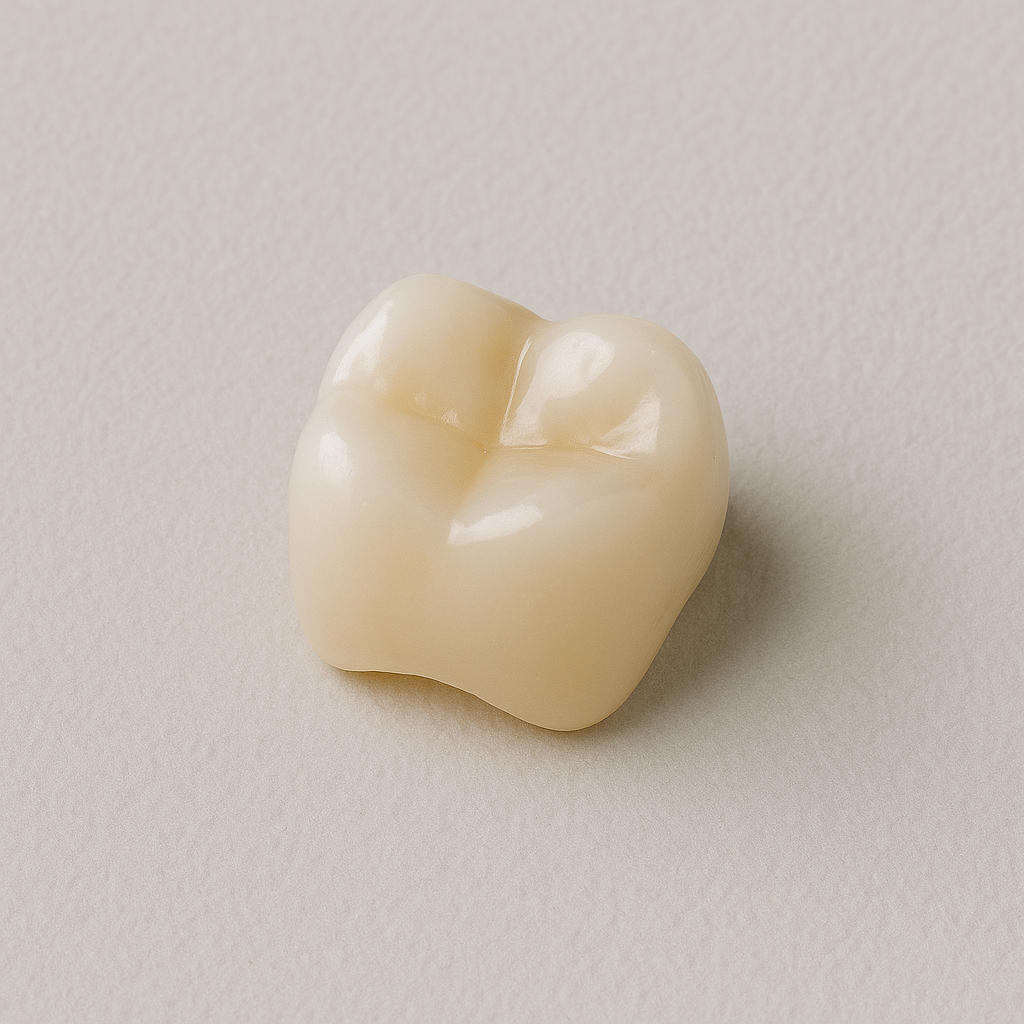The concept of a temporary crown can be difficult to grasp. Why would you deal with the stress, discomfort, and cost of one of these just to have it replaced down the road? What is the purpose of a temporary crown?
Despite their short-term use, these provisional crowns play a pivotal role in protecting the tooth and maintaining functionality while awaiting the permanent crown’s arrival. They also serve aesthetic purposes.
From root canals to dental implants, there are a number of use cases for provisionals. We’ll cover these below along with common materials used and why My DDS Supply is the #1 choice online for temporary crown material.
What is the Purpose of a Temporary Crown?
Let’s start with the basics - what is the purpose of a temporary crown? There are three reasons these are a staple in modern dentistry.
Tooth Protection
The primary purpose of temporary crowns is to protect the tooth after it has been prepared for a permanent crown. The reshaped tooth is vulnerable to damage from external forces and bacteria. In the meantime, a provision can shield the exposed dentin and seal off the tooth from potential contaminants.
This protection helps prevent infections and reduces the risk of sensitivity and discomfort. The tooth could suffer from further decay or complications without this barrier, which would necessitate more extensive dental work.
Maintaining Functionality
The other important use for a temporary crown is functional. Patients still need to eat and speak while they await their permanent crown - which could take weeks if not months in some cases. A properly fitted temporary crown empowers the patient to chew food and talk without difficulty, maintaining their quality of life.
The provisional also keeps the surrounding teeth in their proper positions. Otherwise, adjacent teeth might shift into the gap, leading to alignment issues that could complicate the placement of the permanent crown.
Aesthetic Purposes
Of course, there are aesthetic reasons at play as well. Dental procedures can take time, and patients often do not want to walk around with noticeable gaps or damaged teeth showing every time they open their mouths.
Provisionals are designed to mimic the appearance of natural teeth, serving a cosmetic purpose that maintains the patient's smile. This is especially important for crowns placed on front teeth, helping to preserve patient confidence and comfort.
Situations Requiring Temporary Crowns
You know the purpose of temporary crowns, but what are some of the common scenarios they’re called upon? The short answer is anytime a crown is necessary, you’ll likely need a provision to fill the space in the patient’s mouth while awaiting the permanent crown.
A root canal treatment is one such case in which temporary crowns are needed. During these procedures, the infected pulp of the tooth is removed, and the interior is cleaned and sealed. This can leave the tooth structure weakened and vulnerable to fractures or further decay
Placing a temporary crown on the treated tooth helps protect it from damage and contamination while the permanent restoration is being fabricated.
Temporary crowns are also used in the dental implant process. The implant takes time to integrate with the bone in a process called osseointegration after it’s surgically placed into the jawbone. This can take several months, during which a temporary crown may be used.
This not only maintains the aesthetic appearance of the patient’s smile but also helps shape the gum tissue around the implant, ensuring a natural and seamless fit for the permanent crown.
Materials Used in Temporary Crowns
Now, what are temporary crowns made of? The materials used to create these crowns must be durable, easy to manipulate, and aesthetically pleasing to ensure patient comfort and satisfaction.
We’ll discuss the common choices below, from acrylics to composite resins and more. You’ll also learn why My DDS Supply is the industry’s trusted choice for provisional crown material.
Composite Resins
Composite resins are widely used for their exceptional durability and strength. They can withstand the forces of chewing and grinding, making them ideal for temporary crowns.
They can also be closely matched to the natural color of teeth, providing a more aesthetically pleasing result. They are often chosen for temporary crowns in visible areas of the mouth because of this trait.
From the dental practitioner’s perspective, they’re also easy to manipulate and shape, allowing for precise fitting and adaptation to the prepared tooth.
Acrylics
Acrylic materials are often more affordable than composite resins, making them a popular choice for temporary restorations where budget is a concern.
They’re highly flexible and easy to work with, providing a quick and efficient solution for temporary crowns. They can also be used for a variety of temporary dental restorations, including crowns, bridges, and veneers.
Polycarbonate
A third option you’ll encounter is polycarbonate, which is often pre-formed for a convenient and time-saving approach to provisional crowns. This material offers great strength and durability, suitable for both anterior and posterior teeth.
No matter which option you choose, though, sourcing quality temporary crown material is of the utmost importance to maintain peak productivity in your practice while prioritizing favorable patient outcomes. That’s why professionals around the country trust My DDS Supply.
What Makes My DDS Supply the #1 Choice for Temporary Crown Material?
My DDS Supply is your factory-direct eBay store for all things dental. You get the best selection at the lowest prices, shipped to your practice fast. We back up the entire sourcing experience with exceptional customer support as well.
Our materials offer exceptional strength and durability, providing reliable retention and stability. This means fewer adjustments and better patient outcomes. They’re made with care and attention to detail in Germany, which is known for its high standards and quality control processes.
You gain access to a wide array of shades, including A1, A2, A3, B1, and Bleach. This makes it easy to choose the perfect shade for natural-looking temporary restorations.
Our materials come in intuitive 10:1 mixing ratios, streamlining the preparation process and saving valuable time. With working times of 40 seconds, in-mouth times of 1:30-2:30 minutes, and setting times of just 4 minutes, our materials ensure a quick and efficient workflow.
We aren’t just your trusted choice for temporary crown material. You can also source temporary dental cement, dental syringe, dental bibs, dental face masks, VPS impression material, bite registration material, bite registration trays, and more.
This is your one-stop shop for premium dental supplies and materials at competitive prices that fit your budget. With world-class customer service every step of the way, what more could you ask for? Discover the best selection of temporary crown material today.
Tips for Creating and Caring for Temporary Crowns
We have a more detailed overview of how to make a temporary crown if you’re interested. But before we wrap up this guide on the purpose of temporary crowns, here is a quick look at how these provisionals are created along with tips on caring for them:
Step-by-Step Guide to Provisional Creation
- Tooth Shaping: This involves removing any decay and reshaping the tooth to ensure a proper fit for the crown.
- Impression Taking: An impression of the prepared tooth and surrounding teeth is taken using alginate impression material. This helps craft the provisional to match the patient's bite and alignment.
- Material Selection: Chosen based on the patient's needs and the dentist's preference.
- Mixing and Application: The material is mixed and placed into the impression mold. Once it’s partially set, it’s positioned over the tooth to form the temporary crown.
- Initial Shaping: The provisional is then removed from the mold and any excess material is trimmed away.
- Trial Fitting: The temporary crown is then fitted onto the prepared tooth to check for proper alignment and bite. Adjustments are made to ensure the crown fits comfortably and securely.
- Smooth Finish: The provisional is polished for a smooth surface, which helps reduce irritation to the surrounding tissues and enhances comfort.
- Final Fitting: The crown is placed on the tooth one last time to confirm the fit and make any final adjustments. Once satisfied, the dentist will cement the temporary crown in place using a temporary dental adhesive.
Care Tips
Proper care of provisions keeps them in place and provides adequate protection until the permanent crown is ready. Good oral hygeine is essential throughout the waiting period. But, the patient must be careful to avoid dislodging the provisional.
Brush teeth gently with a soft-bristled toothbrush and non-abrasive toothpaste. Floss carefully around the temporary crown. Instead of pulling the floss up, slide it out to prevent lifting the crown.
Patients should avoid sticky foods like caramel and chewing gum which can dislodge the temporary crown. Similarly, hard foods like nuts or hard candy can break or damage the crown.
Be advised that temporary crowns can increase sensitivity to hot and cold temperatures. Patients should be aware of this and avoid extreme temperatures in their food and drinks.
Parting Thoughts on the Purpose of Temporary Crown
So, what is the purpose of a temporary crown? In closing, these are essential components in restorative dentistry. They provide protection, maintain functionality, and preserve aesthetics while awaiting permanent restorations.
Proper creation and care of these provisional crowns ensure patient comfort and the success of the final treatment, which is why it’s best to set yourself up for success with top-tier materials from My DDS Supply.
Learn more about the world of dentistry in our blog with resources like how long does dental cement last, how to make dental putty at home, how strong is dental cement, dental suctioning techniques, sterilization pouches sizes, how to mix alginate, and more.
But whether you’re looking for temporary crown material or the best gauze for tooth extraction, the different types of dental burs, or anything in between, remember that My DDS Supply is your one-stop shop.
Equip your practice with the best materials for temporary crowns to save time and stress while prioritizing better patient outcomes. See what makes us the industry’s preferred choice today!

